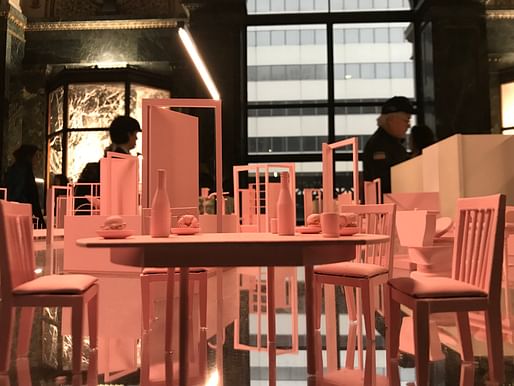
The Chicago Architecture Biennial is a lot. I’m not the first to write about it, certainly won’t be the last, but maybe I’ll be the first to say simply, naively, unequivocally, that it is a lot. Every available space, hallway and corner is put to work in the exhibitional narrative put forth by Sharon Johnston and Mark Lee. Even the building is a lot, a fine example of Chicago’s expertise on the Beaux-Arts style. And when the packed exhibition converges with the ornate building, the result is fairly overwhelming.

There is an immense visual density of information. I appreciate it. It functions well as a blunt instrument to ensure no person could possibly leave without some lingering thought or question regarding at least one thing seen. The exhibition encompasses three floors of the Chicago Cultural Center. Each contribution ranges radically in scale. Unlike the previous iteration, Chicago’s first, there is a theme. Make New History, which proved to be a broad provocation that resulted in some creative interpretations.
The general cultural consensus regarding architecture is that the building is the end product. Architects design buildings. Except in architecture school and within the younger side of the profession, we understand that there might be more to architecture than a building. Architects understand space, systems and how to work systemically. And so the end goal of the Chicago Architecture Biennial is not the building, but the idea. This essentially holds true for most architecture biennials and biennales. Under this broad provocation, there are a thousand propositions and ideas that respond. And as the individual projects respond to the prompt of the biennial, the topics veer into typical architectural discourse. There might be a model of a building to represent the idea, but by being so entrenched in its own language, the relevance becomes muddy.
This exposes an accessibility problem of architecture, at least in the format of the big-scale exhibition where there is a prominent public face. I’m not the first to point to this shortcoming, but I’ll be the most recent. Architects know how to speak to other architects really well. That skill often falls short when it comes time to translate topics of representation or the like into a framework that is comprehensible and reasonable to anyone who does not count themselves as an architect.
The organizers of this year’s biennial made moves to address this. The wall text, which sounds minute but is incredibly important for any exhibition, makes excellent use of common language over architectural jargon. Even when one piece of text lays out the definition of the elevation and why it is relevant to architects, there is a tethering of architectural discourse to the world around it. But common language will never bridge the knowledge gap. How does one assess Andrew Kovac’s contribution without the requisite familiarity with the Soane House? It is visually arresting; it is pretty and it is funny, but without Sloan, is it anything more? I could spend hours Instagramming the sixteen foot Tribune towers, but it just becomes another post about a pretty thing without taking the connection of old history to the present. Wall text may ease the accessibility.
Wall text cannot answer the bigger ‘so what question’ of these architectural propositions. And so then the Biennial becomes an exhibition, not about architecture, but Architecture: capital A, credentials required. I saw many pretty things at the Cultural Center last weekend. There were beautiful models and beautiful drawings all inside some beautiful spaces. But if I, the architect-in-training still left the Biennial exhausted by soaking it all in, then I wonder what those dropping in, those curious passer-bys thought.
Details, impressions, and all those in between memories deserve a voice. It just so happens architecture school has given me a lot of those. I am a 3-Year Masters of Architecture student at Taubman College at the University of Michigan, and we'll see where this gets us.



3 Comments
This person must find it terrifying to walk outside in the morning and be surrounded by things with no wall text
Lol. It's been a difficult adjustment.
* the author must mean "the Soane house" in reference to Andrew Kovacs' project, not the Sloan house. I haven't been to this Chicago biennial, but in particular with Andrew Kovacs - yes, knowledge of the history of the discipline helps 'get into' the work, but I wouldn't say it is a prerequisite for reading it
Oh my jeez. Thank you for the correction. I'm not sure exactly where Sloan came from.
I found the implication of narcissism in the subtitle quite apropos.
Block this user
Are you sure you want to block this user and hide all related comments throughout the site?
Archinect
This is your first comment on Archinect. Your comment will be visible once approved.